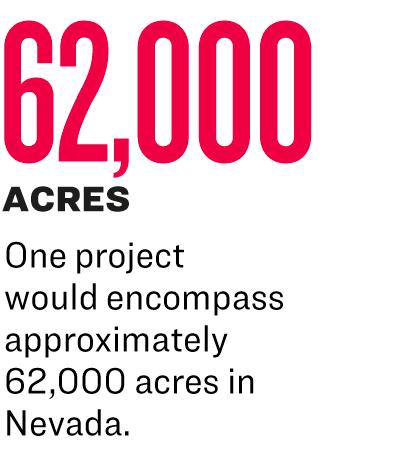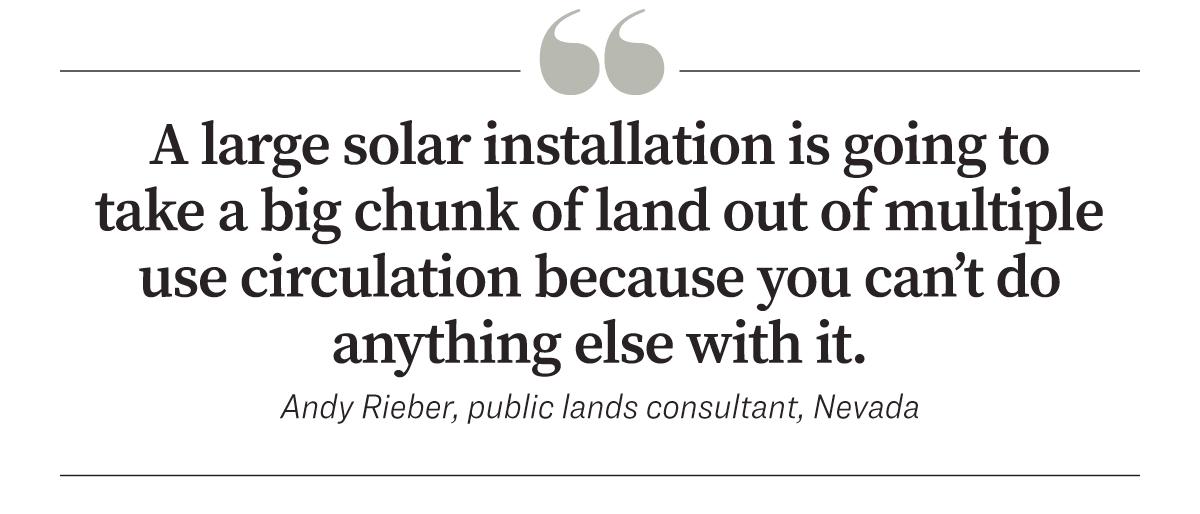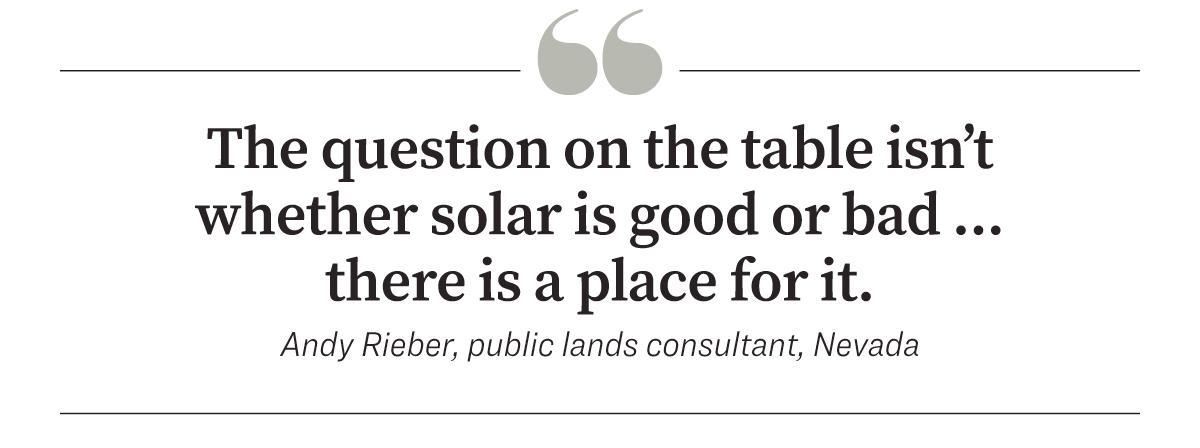Solar energy’s appetite for vast amounts of land has prompted the Biden administration to propose designating as much as 55 million acres of public lands as potential sites for industrial-scale solar farms.
That’s an area larger than 36 states and similar in size to Idaho or Minnesota.
In the most aggressive of these scenarios, 55 million acres across 11 Western states would be made available for solar energy. The least aggressive alternative would designate 8 million acres for that purpose.
The BLM’s “preferred alternative” falls halfway between the two, setting aside 22 million acres for solar development.
In total, the BLM manages 162 million acres of public land designated as “multi-use.” These multiple uses include farming, ranching, hunting and fishing, hiking and camping, drilling, and mining—and more recently, wind and solar installations and transmission lines to connect them to the grid.
The BLM, a division of the Department of the Interior, states that, in order to carry out the Biden administration’s goal of generating 25 gigawatts (GW) of electricity from wind and solar on public lands by 2025—and generating 100 percent “renewable” electricity by 2035—solar panels would need to be sited on 700,000 acres of public land.
More than 3 million solar panels are required to produce 1 GW of electricity, according to the Department of Energy. One GW can power 500,000 to 750,000 homes on average, assuming a constant supply of energy generation and use.
“And this updated solar roadmap will help us get there in more states and on more lands across the West,” she said.
“Our public lands are playing a critical role in the clean energy transition.”
The states targeted for solar development include Arizona, California, Colorado, Idaho, Montana, Nevada, New Mexico, Oregon, Utah, Washington, and Wyoming. This initiative is part of a wider effort to satiate the demand for land from solar companies.
The sheer scope of the BLM plan—designating tens of millions of acres for solar development when the agency says 700,000 acres would suffice to meet Biden administration goals—is a red flag for many communities.
Dylan Hoyt, the planning program manager in the Utah Public Lands policy coordinating office, calls it “bad optics.”
“When I say bad optics, I mean when you tell me that I have 17,000 acres in Utah that’s set aside for solar, and now we’re going to jump to 3.7 or 1.5 million,” he told The Epoch Times.
“That looks terrible.”
The article mentions Robert Moses, New York’s mid-20th-century unelected Parks and Recreation Commissioner, who was responsible for enormous urban planning projects including parks, bridges, and highways that crisscrossed the state.
Among Mr. Moses’s more notorious mega-projects were highway systems such as the Cross Bronx Expressway that ran through urban communities and turned once-vibrant neighborhoods into slums.
‘Destroying the Environment to Save It’
Some who are on the receiving end of the BLM’s solar plan say that, despite assurances from environmental groups, they remain concerned about the scale of this government development project and the amount of land that it would consume.“They say we have to protect the environment, but they’re OK with destroying the environment to save it,” Gabriella Hoffman, policy analyst and host of the “District of Conservation” podcast, told The Epoch Times. “It makes no sense if you’re a conservationist.”
“This idea that we can save the environment by carpeting the rural landscape with oceans of solar panels and forests of wind turbines—it boggles the mind how climate activists can justify this,” he told The Epoch Times.
“It’s definitely going to impact wildlife,” Mr. Hoyt said. And not only an impact on species that live in the designated solar zones but also on those that migrate through them.
“There’s definitely going to be conflicts with ranchers, there could be conflicts with access to public lands depending on where it’s built, and there could be potential conflicts with the mining industry,” he said.
“States didn’t really have a say in the goals in the first place, which I think is disconcerting because the states represent the citizens.”
From Multi-Use to Single-Use
One of the prime target states for solar development is Nevada, both because of the amount of sunlight it receives and because of its proximity to California and Las Vegas, with their ever-expanding demands for electricity.The federal government owns 85 percent of Nevada’s land, most of which is desert, but residents dispute the notion that it is devoid of wildlife and say they are concerned about the sheer scale of BLM’s solar plan.
“Nevada is hard-rock mining country,” Andy Rieber, a public lands consultant residing in Nevada, told The Epoch Times, “but the average footprint in Nevada for mining disturbance is less than 1,000 acres.

“They come in, they build on federal lands, and they pay a permit fee to the Bureau of Land Management, but the local economy gets nothing,” he said.
While the BLM initiative touts “environmental justice” among its guiding principles, people in targeted states worry that poorer rural communities will feel the impact of solar development, but that the electricity produced will be delivered to wealthier urban centers in states such as California.
“Yes, we need to be considerate of environmental impacts,” Mr. Hoyt said. “But at the same time, we’re coming in and we’re putting a huge transmission line and a solar field, and then when it’s done those people still have it there and have to look at it and live with it, but they get nothing from it.”
Another issue that many cite with using multi-use public lands for solar is that solar energy crowds out other uses on the land.
“One of the things that is unique about solar development is that it doesn’t really play well with others,” Mr. Rieber said.
“If you have a grazing allotment, a lot of things can go on in and around that, including recreation, even mining,” he said. “But a large solar installation is going to take a big chunk of land out of multiple-use circulation because you can’t do anything else with it; it’s a singular use.”
Public Comment Period
The BLM reports that it has, as of December 2022, permitted more than 9 GW of solar energy development, 3 GW of wind energy development, and 1.6 GW of geothermal energy development on public lands. The BLM has also permitted 17 transmission lines, crossing BLM-administered lands, to connect these facilities into the electric grid.“You too can weigh in; you don’t need to be a policy analyst, you can be a regular citizen,” Ms. Hoffman said. “This is what these comment periods are for; you can just write a sentence, simple as that.”
Meanwhile, public officials believe there’s a way to allow solar development that will be acceptable to local communities.
“The question on the table isn’t whether solar is good or bad; I think everyone ascertains that there is a place for it,” Mr. Rieber said. “The question on the table, rather, is let us proceed with this development in a way that we won’t regret in the future.”
Mr. Hoyt said that if the BLM proceeds with the Western Solar Plan as currently written, lawsuits will likely be the result.
“We don’t want to see litigation around solar development,” he said. “We have great relationships in Utah with our BLM employees, and we want to keep it that way.”
The full article can be read at https://www.theepochtimes.com/article/rural-america-set-to-be-trans...
*************************************
Fair Use Notice: This website may reproduce or have links to copyrighted material the use of which has not been expressly authorized by the copyright owner. We make such material available, without profit, as part of our efforts to advance understanding of environmental, economic, scientific, and related issues. It is our understanding that this constitutes a "fair use" of any such copyrighted material as provided by law. If you wish to use copyrighted material from this site for purposes that go beyond "fair use," you must obtain permission from the copyright owner.


You need to be a member of Citizens' Task Force on Wind Power - Maine to add comments!
Join Citizens' Task Force on Wind Power - Maine